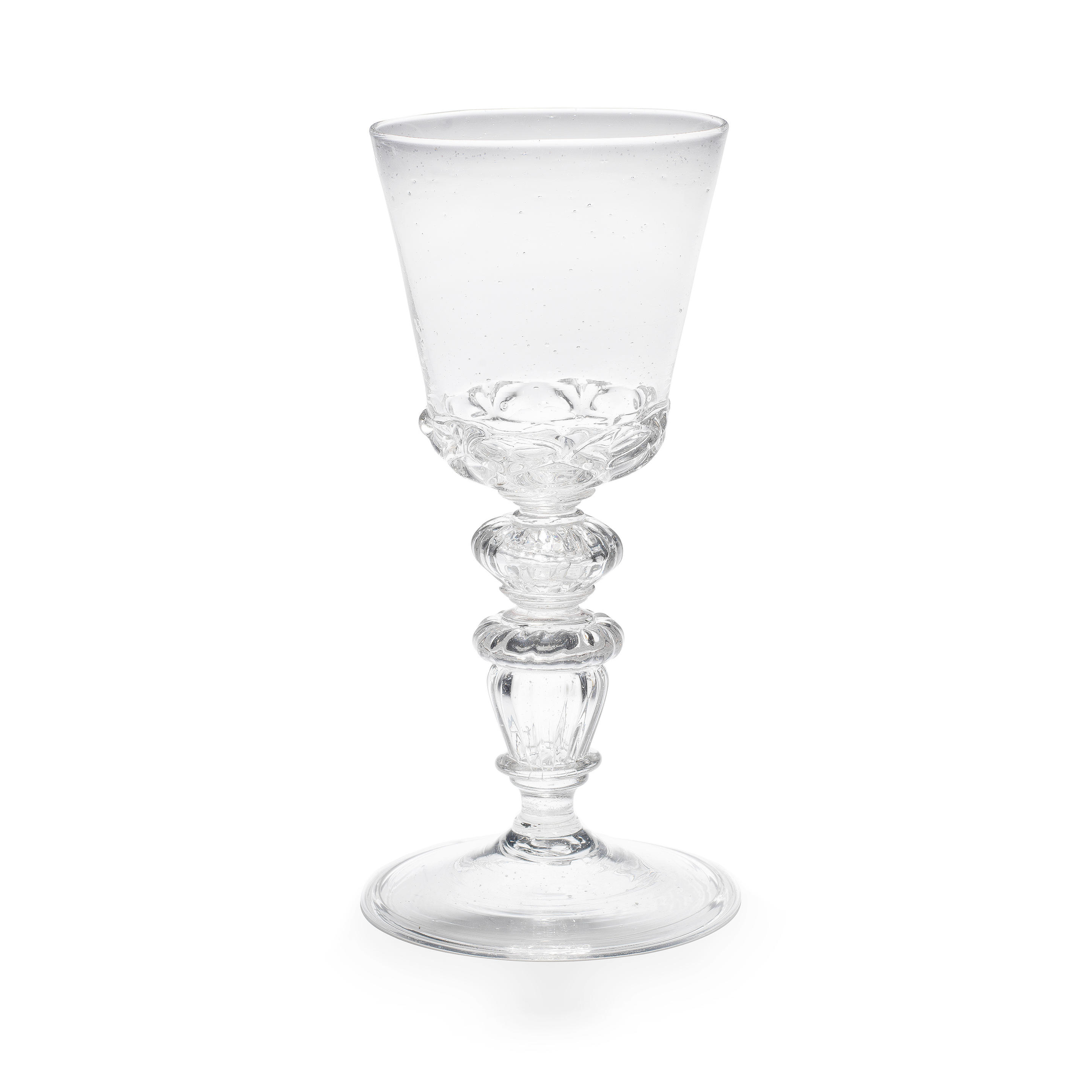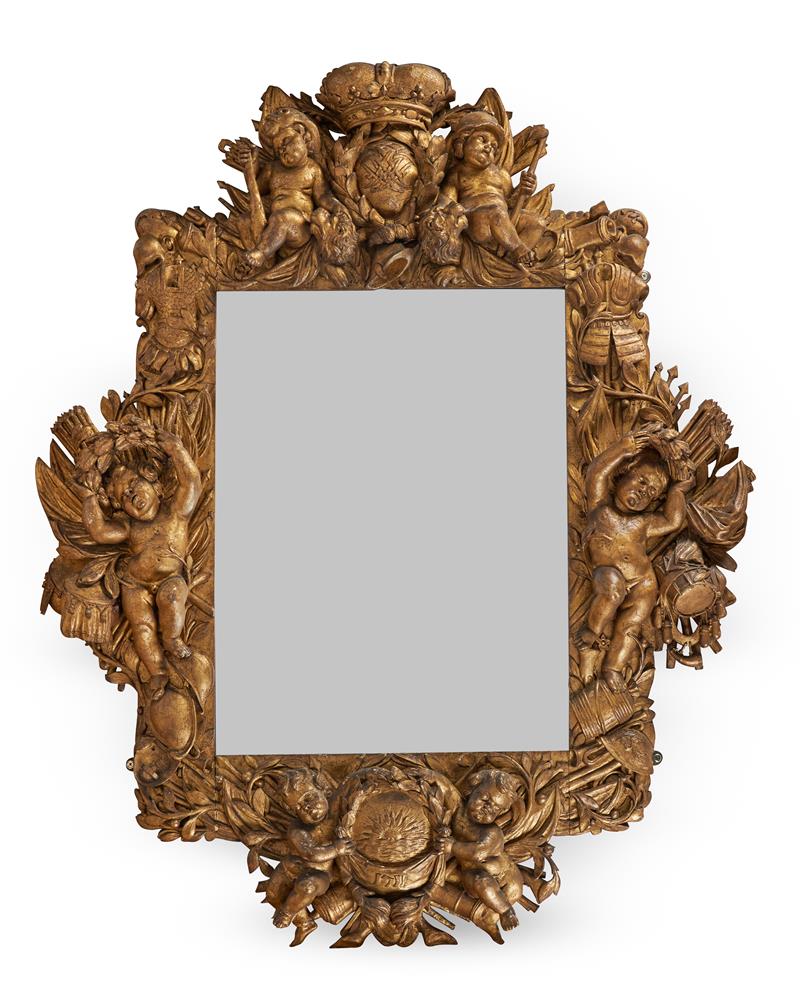A late 17th century walnut inlaid longcase clock of one month durationJohn Cotsworth, London the hood with stepped and domed ebonised caddy over an inlaid frieze supported on spirally twisted columns to the front over a decorated throat moulding and long door fully inlaid with a lavish design of flowers and foliage issuing from a classical urn, on a matching base. The 11-inch square brass dial with wide winged cherubs head spandrels between engraved foliage framing the Roman and Arabic chapter ring, the matted centre with central rose engraving, ringed winding squares and decorated date aperture. The movement of one month duration with six substantial knopped and finned pillars, the small outside countwheel mounted on the top right-hand side of the backplate, now striking on a long, coiled gong mounted on the backboard. Together with a pendulum and pair of brass clad weights. The case of the same period, but probably associated. 2.26m (7ft 5ins) highFootnotesJohn Cotsworth was born in 1637. He was initially apprenticed to Nicholas Coxeter, before being turned over to Jeremy Gregory. He gained his freedom of the Clockmakers on 5 July 1669. In 1698, he took out a 13-year lease on a shop in St. Dunstan's-in-the-West. The shop was described as being at the south-west end of St. Dunstan's church, next to Cliffords Inn Lane. Cotsworth and the shop clerk, John Grant were listed as the sole occupiers of the shop. As Grant is described as being from St. Dunstan's-in-the-West, it is possible that he remained on in the shop irrespective of the owner, rather than having a specific relation with Cotsworth. Cotsworth is mentioned as having also been an engraver; as his second master, Jeremy Gregory, is believed to have gained his freedom from the Goldsmith's Company, it is possible that Cotsworth learnt engraving from him. It has been suggested that Cotsworth was a non-conformist, but this has not been proved. Throughout his career, Cotsworth would take five apprentices, three of whom were freed, perhaps the most famous being Edward Crouch. Crouch became Cotswoth's apprentice in 1682, gaining his freedom in 1691. By 1719, Crouch had become the Master of the Company, unfortunately dying four years later. Interestingly, Crouch's shop throughout his career is listed as being in St. Dunstan's-in-the-West. What relationship he maintained with Cotsworth after his apprenticeship remains unknown. John Cotsworth died in 1732; he was 95 years old, and was described as a watchmaker and the oldest living resident of St. Dunstan's-in-the-West. In his will, he left instructions that his Grandsons/Godsons, Cotworth and Robert, the sons of seemingly his only living child, Elizabeth, were each to receive £50. A Month going longcase from 1730 is also known from him, and a similar month going longcase by Crouch was sold by Bonhams in 2006. Boney, G. (1992) 'Harry Callowe: A Sequel' Antiquarian Horology Vol. 20 (2) p. 157 British Horological Institute (1974) 'Clocks recently sold', Horological Journal Vol.116 (11) p. 26. Atkins, C. (1931) The Company of Clockmakers: Register of Apprentices. London: Butler & Tanner Ltd. Atkins, C. E. (1931) Register Of Apprentices Of The Worshipful Company Of Clockmakers Of The City Of London From Its Incorporation in 1631 To Its Tercentenary In1931 Compiled From The Records Of The Company By Charles Edward Atkins, Master In 1897, 1909 And 1928. Compiled by Jeremy Lancelotte Evans. London: The Company of Clockmakers.
A late 17th century walnut inlaid longcase clock of one month durationJohn Cotsworth, London the hood with stepped and domed ebonised caddy over an inlaid frieze supported on spirally twisted columns to the front over a decorated throat moulding and long door fully inlaid with a lavish design of flowers and foliage issuing from a classical urn, on a matching base. The 11-inch square brass dial with wide winged cherubs head spandrels between engraved foliage framing the Roman and Arabic chapter ring, the matted centre with central rose engraving, ringed winding squares and decorated date aperture. The movement of one month duration with six substantial knopped and finned pillars, the small outside countwheel mounted on the top right-hand side of the backplate, now striking on a long, coiled gong mounted on the backboard. Together with a pendulum and pair of brass clad weights. The case of the same period, but probably associated. 2.26m (7ft 5ins) highFootnotesJohn Cotsworth was born in 1637. He was initially apprenticed to Nicholas Coxeter, before being turned over to Jeremy Gregory. He gained his freedom of the Clockmakers on 5 July 1669. In 1698, he took out a 13-year lease on a shop in St. Dunstan's-in-the-West. The shop was described as being at the south-west end of St. Dunstan's church, next to Cliffords Inn Lane. Cotsworth and the shop clerk, John Grant were listed as the sole occupiers of the shop. As Grant is described as being from St. Dunstan's-in-the-West, it is possible that he remained on in the shop irrespective of the owner, rather than having a specific relation with Cotsworth. Cotsworth is mentioned as having also been an engraver; as his second master, Jeremy Gregory, is believed to have gained his freedom from the Goldsmith's Company, it is possible that Cotsworth learnt engraving from him. It has been suggested that Cotsworth was a non-conformist, but this has not been proved. Throughout his career, Cotsworth would take five apprentices, three of whom were freed, perhaps the most famous being Edward Crouch. Crouch became Cotswoth's apprentice in 1682, gaining his freedom in 1691. By 1719, Crouch had become the Master of the Company, unfortunately dying four years later. Interestingly, Crouch's shop throughout his career is listed as being in St. Dunstan's-in-the-West. What relationship he maintained with Cotsworth after his apprenticeship remains unknown. John Cotsworth died in 1732; he was 95 years old, and was described as a watchmaker and the oldest living resident of St. Dunstan's-in-the-West. In his will, he left instructions that his Grandsons/Godsons, Cotworth and Robert, the sons of seemingly his only living child, Elizabeth, were each to receive £50. A Month going longcase from 1730 is also known from him, and a similar month going longcase by Crouch was sold by Bonhams in 2006. Boney, G. (1992) 'Harry Callowe: A Sequel' Antiquarian Horology Vol. 20 (2) p. 157 British Horological Institute (1974) 'Clocks recently sold', Horological Journal Vol.116 (11) p. 26. Atkins, C. (1931) The Company of Clockmakers: Register of Apprentices. London: Butler & Tanner Ltd. Atkins, C. E. (1931) Register Of Apprentices Of The Worshipful Company Of Clockmakers Of The City Of London From Its Incorporation in 1631 To Its Tercentenary In1931 Compiled From The Records Of The Company By Charles Edward Atkins, Master In 1897, 1909 And 1928. Compiled by Jeremy Lancelotte Evans. London: The Company of Clockmakers.















Testen Sie LotSearch und seine Premium-Features 7 Tage - ohne Kosten!
Lassen Sie sich automatisch über neue Objekte in kommenden Auktionen benachrichtigen.
Suchauftrag anlegen